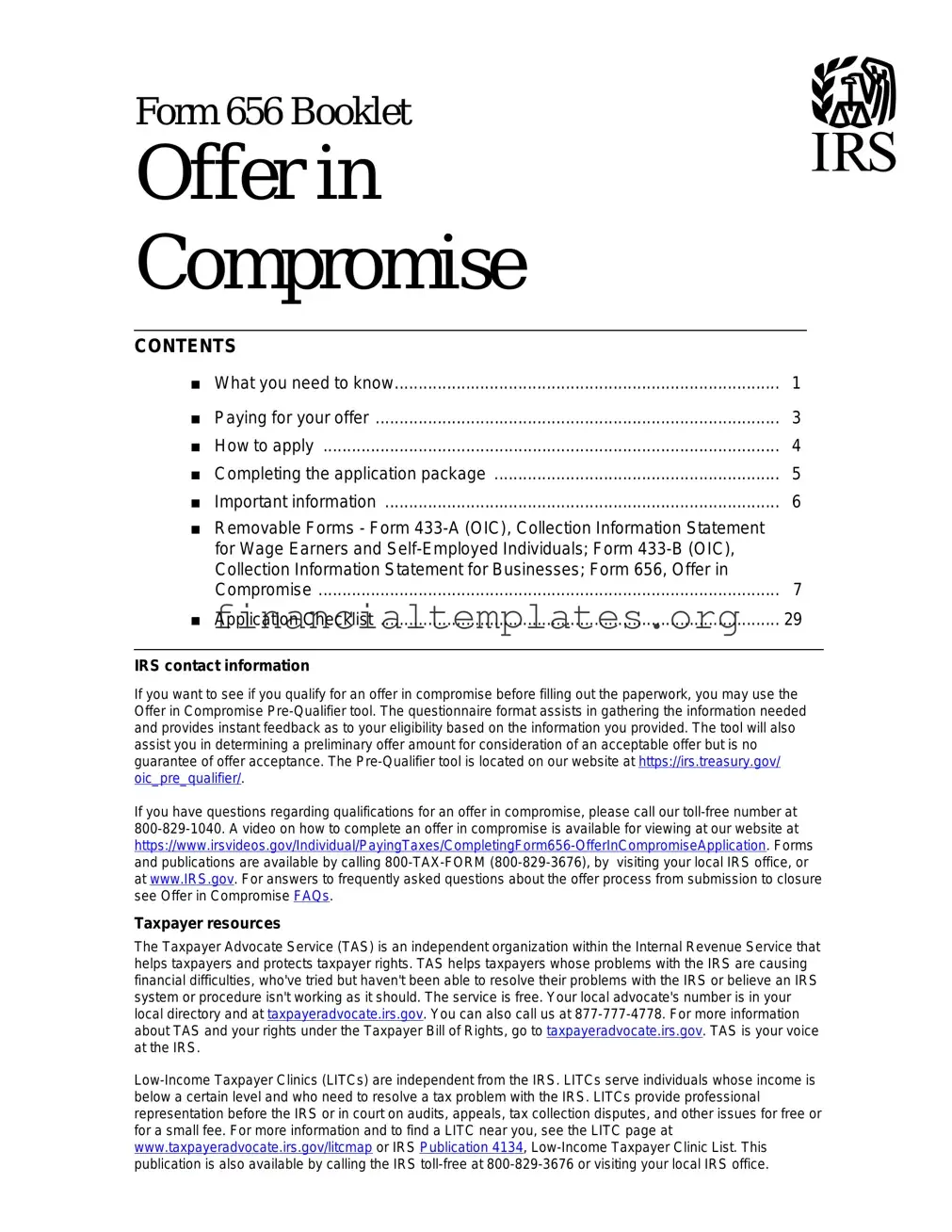The Form 433-A (OIC), Collection Information Statement for Wage Earners and Self-Employed Individuals, bears resemblance to the IRS 656 form in several aspects. Both documents require detailed financial information to assess the taxpayer's ability to pay their tax debt. While Form 656 initiates a request for an Offer in Compromise, Form 433-A provides the IRS with the necessary financial details to evaluate the taxpayer’s offer. This evaluation is crucial, as it determines the feasibility of the requested compromise by analyzing the taxpayer’s income, expenses, and asset equity.
Form 433-B (OIC), Collection Information Statement for Businesses, is another document similar to the IRS 656 form, targeted towards businesses seeking an Offer in Compromise. Like its counterpart for individuals, this form collects financial data but focuses on the business’s financial health, including assets, liabilities, and operational expenses. The completion of this form is pivotal for businesses to illustrate their incapability to fulfill their full tax liabilities, thereby necessitating the consideration for an Offer in Compromise encapsulated within Form 656.
Form 656-L, Offer in Compromise (Doubt as to Liability), shares a foundational purpose with Form 656; both aim to resolve tax liabilities under specific conditions. However, Form 656-L is distinct as it caters to taxpayers disputing the accuracy of the tax debt imposed on them, endeavoring for an adjustment on the grounds of doubt regarding the liability amount. While Form 656 addresses the ability to pay, Form 656-L centers on disputing the actual tax debt, reflecting different facets of resolving tax liabilities with the IRS.
IRS Form 1040, the U.S. Individual Income Tax Return, although primarily a tax filing document, indirectly relates to Form 656 as part of the prerequisite conditions. Before considering an Offer in Compromise through Form 656, taxpayers must ensure they’ve filed all required tax returns, including Form 1040. This compliance serves as a critical initial step in demonstrating the taxpayer’s commitment to rectifying their tax situation, thereby affecting the eligibility and assessment process of their offer.
The Application for Reduced User Fee for Installment Agreements similarly links with the concept of alleviating the taxpayer's financial burden, akin to Form 656. Though this application focuses on reducing the fee for establishing a payment plan, it aligns with the Offer in Compromise’s objective of making tax liabilities manageable for financially constrained taxpayers. Both documents facilitate the IRS’ engagement in solutions aimed at recovery of debts in consideration of the taxpayer's ability to fulfill their obligations.
IRS Form 2848, Power of Attorney and Declaration of Representative, complements the aim of Form 656, albeit through a different mechanism. Taxpayers looking to submit an Offer in Compromise may utilize Form 2848 to authorize a tax professional to act on their behalf in negotiations and communications with the IRS. This legal representation can be pivotal in effectively presenting and managing an Offer in Compromise, demonstrating the forms’ collaborative roles in addressing tax liabilities.
Form 8821, Tax Information Authorization, while not directly part of the Offer in Compromise process, supports it by allowing designated individuals to access a taxpayer’s information, which can be instrumental in preparing a comprehensive and accurate Form 656. By enabling a tax professional to review tax histories and liabilities, Form 8821 assists in gathering the necessary backdrop and details for a viable Offer in Compromise.
The Collection Information Statement for Wage Earners and Self-Employed Individuals, without a specific form number akin to Form 433-A (OIC), serves a parallel purpose. It underscores the necessity for taxpayers to comprehensively disclose their financial landscape. This detailed disclosure is essential for the IRS to ascertain the taxpayer’s capability to settle their tax debt, echoing the informational requirements posed by Form 656 in the Offer in Compromise process.
Lastly, the Department of Justice’s role in tax liability settlements, though not encapsulated in a singular form, intersects with the conditions outlined in Form 656 regarding the ineligibility for an Offer in Compromise during ongoing Department of Justice proceedings. This contextual similarity underlines the broader regulatory and procedural framework within which tax liabilities and compromises are navigated, demarcating the boundaries and possibilities for tax debt resolution efforts.







